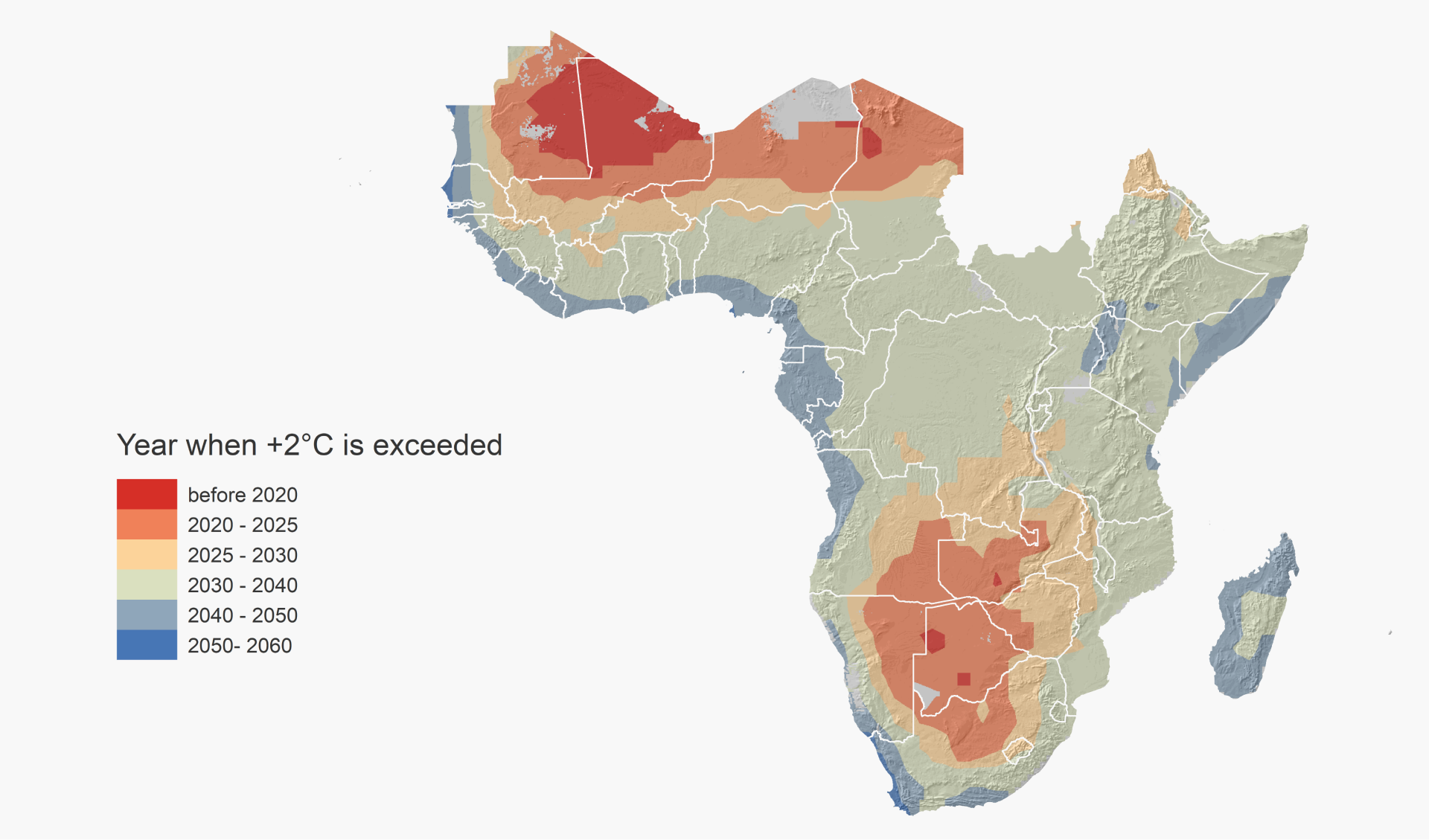Introduction
Climate change is happening now. The Intergovernmental Panel on Climate Change (IPCC) Fifth Assessment Report indicates that global average temperatures have consistently risen in the last 100 years as a result of anthropogenic greenhouse gas emissions.

Image credit: ©2015CIAT/GeorginaSmith
Temperatures and other variables will cross dangerous thresholds
Reported annual global temperature records show that the global average 2017 temperatures are likely between 0.8°C and 1.2°C above pre-industrial levels. The world, therefore, is already on a trajectory of relatively rapid climate change, and temperatures and other variables will cross dangerous thresholds and become harmful for crop and livestock production systems.

Map 1 Year in which +2oC temperature change with respect to pre-industrial levels is projected to occur during the 21st century, for Representative Concentration Pathway (RCP) 8.5.
Across sub-Saharan Africa, local +2°C exceedance occurs, at the latest, by 2050
Climate projections can be used to determine the times at which local mean temperature exceeds 2°C above pre-industrial levels. Using the Coupled Model Intercomparison Project phase 3 (CMIP3) climate model ensemble, Joshi et al. (2011) suggest that, across sub-Saharan Africa, local +2°C exceedance occurs, at the latest, by 2050. Based on CMIP5 projections focusing on the current emissions trajectory (RCP 8.5) (Map 1)*, the same two-degree target is exceeded across the Sahel before 2030.
Similar exceedance times are projected for most of Southern Africa. Southern West Africa, Central Africa, and East Africa show later projected times of exceedance (up to 2050). The latest exceedance occurs in coastal areas (2050–2060).
Local temperatures exceed 2°C are expected to lead to drying across most of SSA
By 2050, virtually all agricultural land and populations in sub-Saharan Africa are projected to experience temperatures that are 2°C warmer than pre-industrial levels. Precipitation changes at the time when local temperatures exceed 2°C are expected to lead to drying across most of SSA, with the exception of East Africa and the central part of the Sahel. Some of these changes are projected to exceed natural variability, thus leading to more severe climates than those experienced by farmers to date (Rojas et al., 2019).
Large commercial and smallholder systems tend to start exceeding the 2°C target earlier than other systems
Regional variations in the timings of the 2°C exceedance across sub- Saharan Africa will result in variations in such timings between different farming systems. Pastoral, agropastoral (e.g., livestock with millet/sorghum production), irrigated, and large commercial and smallholder systems tend to start exceeding the 2°C target earlier than other systems. Rice-tree crop systems, for example, exceed 2°C later in the century.
Variations as to when the 2°C limit is crossed for different farming systems, contexts and countries imply different timescales of impact and, therefore, of adaptation actions to be taken.
Investment will be required to create an environment to facilitate adaptation
Maps 2 and 3 show projections of when maize and bean cropping systems become unsuitable and, therefore, require transformational change. For maize, West Africa shows the earliest requirement for transformation, especially toward the Sahel. For beans, substantial areas especially in East and Southern Africa show relatively early (pre-2030) requirements for transformational adaptation.
In these areas, farmers will experience multiple hazards and, as cropping systems cross dangerous thresholds, they will require support to enable adaptation. In many of these areas, substitution crops are available, and investment will be required to create an environment to facilitate adaptation and take advantage of emerging opportunities.